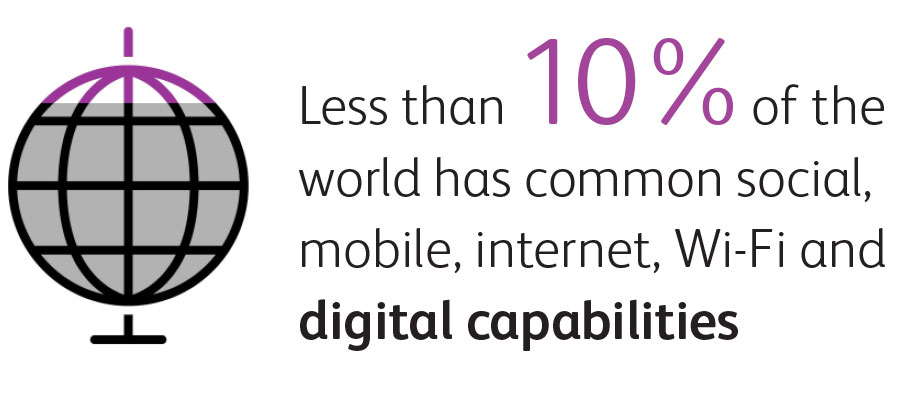
Governments Are Going Digital, Yet Paper Still Persists
Driving Forces for Digital Government
Practically every month another country or local government goes paperless. Research across the globe shows why the world’s governments are adopting digital practices.
Digital expectations. The Emergence of the social web has completely shifted citizens’ expectations for the way they communicate, connect and work. People want 24/7 access from their smartphones to any information they need, including government records.
Efficiency. Paper-based processes are notoriously slow. Digitizing and streamlining these processes helps reduce steps and errors, ultimately saving governments time and money.
Environmental imperatives. Governments consume a lot of resources handling paper. If Unused printed government forms can generate a lot of waste. Going digital provides a path for governments to become environmentally responsible.
Security and data protection. Paper documents can be misplaced, lost or destroyed. Sensitive data can more easily be protected in digital systems through safeguards like passwords, access limitations, data encryption and two-factor authentication.

Open, reusable data. Digital government data can feed multiple systems and databases the public wants to access, such as maps, weather, property records, medical research and more.
Better citizen service. Digitizing government records makes them more easily accessible, leading to faster service, greater transparency and more satisfied constituents.
Regulatory mandates. When governments consider the points above, they see the writing on the digital wall. They know paperless government is the way to go. Often, issuing mandates is the only way to get there. It has taken acts, such as the U.S. Presidential Directive on Managing Government Records and Denmark’s digital-first mandate for government-citizen interactions, to finally make headway and achieve paperless government goals.
Key Reasons Paper Still Persists
Government agencies want to go digital, but paper blocks their path. Why, in this digital tech age, does paper still get in the way? Here are six big reasons why paper is still so prevalent in the public sector.
1. Everything isn’t born digital, especially in the past. Personal digital has only been with us in recent history—just the past 30-40 years. For thousands of years prior, information resided in paper, or else it’s gone. Yes, things happen faster in digital form, but governments can’t go paperless overnight.
2. Inherent convenience of paper. Most people have a high comfort level with paper. You can’t deny its ease and portability for things like collecting a patient’s health history or getting a signature. And paper is the go-to method for ad hoc collaboration.
3. Constraints such as longer procurement cycles and spending restrictions (compared to commercial sectors) often prevent government agencies from adopting cutting-edge technology.
4. Not everyone has digital access. Less than 10% of the world has common social, mobile, internet, Wi-Fi and digital capabilities. Therefore, digital is not yet a common denominator.

5. Preset standards for privacy, security, image fidelity and information backups continue to propagate paper documents in government agencies. For instance, without high-resolution image capture, digitized documents may be blurry or unreadable, rendering them useless. In that case, paper is safer.
6. Lack of systems or data exchange capabilities between areas of the public sector. For example, if Interpol and a local police bureau don’t have sharing-enabled backend systems in place to exchange digital information securely, then they must transfer paper files instead.
Constructive Steps to Take Paper Digital
Governments are going paperless, but paper will be around for a while. That’s the reality.
Follow these steps to go digital while dealing with all that paper.
Build paper-to-digital on-ramps.
Design systems and workflows that account for both paper and digital. By planning for both formats, it’s easier to flex and shift between the two, allowing for greater adoption.
Use hardware that’s built for paper in the real world.
Real documents are odd-sized, rarely perfect, and often double-sided or multi-page with notes scribbled in the margins. When converting physical documents to digital, you need powerful technology that can reliably handle any shape or size you throw at it.
Prioritize citizen impact.
Chances are, the processes that affect citizens most are the ones you’ll see the biggest ROI from digitizing. When you put digital capture at the point of citizen interaction, you provide faster customer service and easier access to data.
Make data readable, searchable and useful.
Simply scanning paper is not enough. You need the right capture software with tools for speed, organization and image acuity. With crystal-clear scans, you can derive meaning from content through optical character recognition (OCR), searchable digital files, customized workflows and automated routing.
Get serious about historical document conversion.
Backfile conversion may seem like a tedious task, but you only need to do it once. It will tremendously improve access to historical information for government employees and the public alike. The right technology—such as a built-in automatic document feeder (ADF) for rapid, unattended scanning—makes backfile conversion quick and painless
How We Can Help
When you’re ready to tackle the opportunity to take your government digital, Xerox scanners will handle all that paper. Our desktop, departmental and production scanners are built for the public sector. We offer simple operation thanks to Visioneer’s OneTouch® software and TWAIN DriverPLUS with Acuity for precise scans and customized solutions. See how our customers are using our technology, and take a look at our offerings.
See Our Government Case Studies
Backfile conversion reduces binders full of backups
A school system can finally ditch the paper they used to keep for audits. Now they simply scan and get on with their day.
From problem paper to a secure Government scanning solution
While replacing a misfeed-prone production scanner, we designed a new workflow, simplifying work, adding security and saving time every day.
Digitizing declaration forms for Customs inspectors
Creating a customized scanning solution within budget helped H.M. Customs Bermuda organize, search and retrieve declaration forms electronically.

